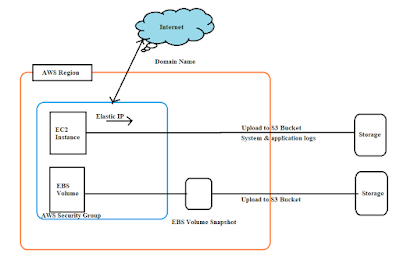Amazon AWS Overview and its Architecture
Amazon Web Services (AWS) is Amazon’s cloud website hosting platform.
It offers flexible, reliable, scalable, easy-to-use and price-powerful solutions.
Architecture:
S3 (Simple Storage Service):
S3 allows the users to store and retrieve various types of data using API calls. It doesn’t contain any computing element.
Load Balancing:
Load balancing certainly means hardware or software load over web servers that improves the efficiency of the server as well as the application. Hardware load balancer is a network appliance used in traditional internet application architectures.
AWS presents the Elastic Load Balancing provider, it distributes the visitors to EC2 instances throughout multiple available resources, and dynamic addition and elimination of Amazon EC2 hosts from the load-balancing rotation.
Elastic Load Balancing can dynamically develop and reduce the load-balancing capacity to modify to visitors demands and also help sticky classes to deal with extra advanced routing needs.
Amazon Cloud-front:
It is accountable for content material transport, i.e. Used to supply website. It may additionally comprise dynamic, static, and streaming content with the use of a worldwide community of part locations. Requests for content material on the user's end are automatically routed to the closest aspect location, which improves the overall performance.
Amazon Cloud-front is optimized to work with different Amazon Web Services, like Amazon S3 and Amazon EC2. It also works pleasant with any non-AWS starting place server and stores the original documents in a similar way.
In Amazon Web Services, there aren't any contracts or monthly commitments. We pay only for as a whole lot or as little content material as we deliver via the carrier.
Elastic Load Balancer:
It is used to spread the site visitors to web servers, which improves overall performance. AWS gives the Elastic Load Balancing service, wherein site visitors are allotted to EC2 times over multiple availability zones and dynamic addition and removal of Amazon EC2 host from the load-balancing rotation.
Elastic Load Balancing can dynamically expand and reduce the load-balancing capacity as in keeping with the site visitor’s situations.
Security Management:
Amazon’s Elastic Compute Cloud (EC2) provides a feature called security groups, which is similar to an inbound network firewall, in which we have to specify the protocols, ports, and source IP ranges that are allowed to reach your EC2 instances.
Each EC2 instance can be assigned one or more security groups, each of which routes the appropriate traffic to each instance. Security groups can be configured using specific subnets or IP addresses which limits access to EC2 instances.
Elastic Caches:
Amazon Elastic Cache is an internet service that manages the memory cache in the cloud. In memory manage, a cache has a totally important role and allows lessening the burden at the offerings, improves the general overall performance and scalability at the database tier with the useful resource of caching frequently used facts.
Amazon RDS:
Amazon RDS (Relational Database Service) affords a comparable get entry to as that of MySQL, Oracle, or Microsoft SQL Server database engine. The equal queries, programs, and tools may be used with Amazon RDS.
It mechanically patches the database software program and manages backups as according to the person’s preparation. It additionally helps point-in-time restoration. There are no up-front investments required, and we pay simplest for the sources we use.
Hosting RDMS on EC2 Instances:
Amazon RDS allows customers to put in RDBMS (Relational Database Management System) of your preference like MySQL, Oracle, SQL Server, DB2, and many others. On an EC2 instance and may manage as required.
Amazon EC2 makes use of Amazon EBS (Elastic Block Storage) much like a network-attached garage. All facts and logs running on EC2 instances have to be located on Amazon EBS volumes, with the intention to be to be had although the database host fails.
Amazon EBS volumes routinely provide redundancy inside the availability region, which will increase the supply of easy disks. Further, if the quantity is not enough for our databases desires, an extent may be delivered to growth the performance of our database.
Using Amazon RDS, the service provider manages the garage and best recognition for coping with the information.
Storage & Backups:
AWS cloud offers numerous alternatives for storing, gaining access to, and backing up web software information and property. The Amazon S3 (Simple Storage Service) presents a simple net-offerings interface that can be used to keep and retrieve any quantity of data, at any time, from anywhere on the web.
Amazon S3 shops facts as gadgets within resources referred to as buckets. The person can store as many items as in line with the requirement within the bucket and can study, write and delete objects from the bucket.
Amazon EBS is effective for facts that desire to be accessed as block garage and requires persistence past the life of the running example, inclusive of database walls and application logs.
Amazon EBS volumes can be maximized up to at least one TB, and these volumes may be stripped for larger volumes and elevated overall performance. Provisioned IOPS volumes are designed to fulfill the desires of database workloads which might be touchy to garage overall performance and consistency.
Amazon EBS presently helps up to 1,000 IOPS in keeping with volume. We can stripe multiple volumes together to supply heaps of IOPS consistent with an example to an application.
Auto Scaling:
The distinction amongst AWS cloud form and the conventional hosting version is that AWS can dynamically scale the internet software fleet on call to cope with modifications in traffic.
In the traditional net website hosting version, visitors forecasting models are normally used to provision hosts in advance of projected traffic. In AWS, instances may be provisioned at the fly steady with a tough and fast of triggers for scaling the fleet out and again it. Amazon Auto Scaling can create functionality organizations of servers that might grow or decrease in demand.



Comments
Post a Comment